Search Results

- IDNO:
- 041185
- Title:
- Civilian Medical Worker and Armed Soldier in Germany
- Date:
- ca. 1945
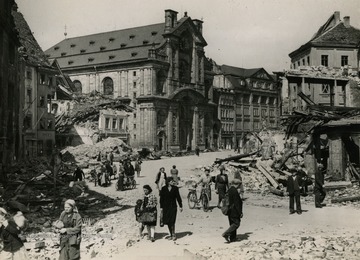
- IDNO:
- 041186
- Title:
- Battered Bamberg Cleared of Enemy, Bamberg, Germany
- Date:
- 1945/04/14
- Description:
- Information on back of photo reads: "Civilians move about on a street in a shell-torn Bamberg, Germany, after occupation of the city by troops of the Seventh U.S. Army April 14, 1945. Enemy forces withdrew from the medieval city, 30 miles northwest of Nurenberg, after a short fight. The retreating Nazis blew up the bridge across the Main and Renitz Rivers, leaving Bamberg an island."
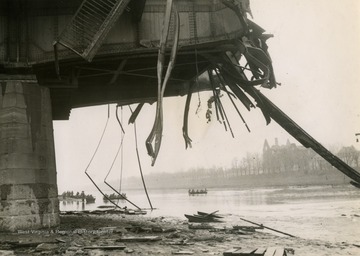
- IDNO:
- 041187
- Title:
- Neckor River, Mannheim, Germany
- Date:
- 1945/03/29
- Description:
- Soldiers in the background cross the Neckor River in Mannheim, Germany. Destroyed bridge is in the foreground.
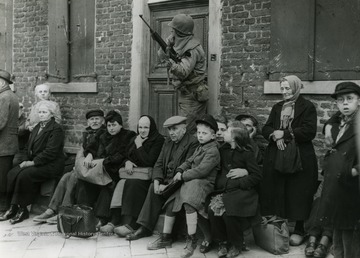
- IDNO:
- 041188
- Title:
- Civilians of Captured German Town, Neuss, Germany
- Date:
- ca. 1945
- Description:
- Information on back of photo reads: "German civilians sit with their children outside of a house in a Reich town captured by troops of the Ninth U.S. Army advancing to the Rhine River. The civilians have been lined up for questioning by an American officer. Units of the Ninth Army reached the Rhine March 2, 1945, when they captured Neuss opposite the industrial center of Dusseldorf."
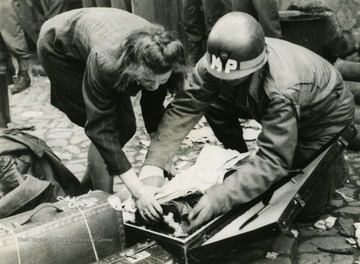
- IDNO:
- 041189
- Title:
- German WAC Captured, Germany
- Date:
- ca. 1945
- Description:
- Information on back of photo reads: "Private Thomas H. Olsen of Chicago, Illinois, checks over the baggage brought by one of the German Army women to the prisoner-of-war enclosure of the 83rd Infantry Division, Ninth U.S. Army. The women surrendered after receiving leaflets. Supreme Headquarters Allied Expeditionary Force reported May 1, 1945, that nearly three million German prisoners had been taken by the Allies in the West since "D-Day" (June 6, 1945)."
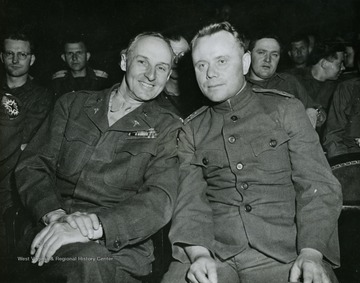
- IDNO:
- 041190
- Title:
- Allied Officers Attend Show Given By Freed Russians, Lippstadt, Germany
- Date:
- ca. 1945
- Description:
- Information on back of photo reads: "Colonel H.A. Forlong (left) of Pontiac, Michigan, Surgeon of the 18th Corps, Ninth U.S. Army, sits beside a Russian Army officer at a stage show given in Lippstadt, Germany, May 20, 1945, by liberated Russian soldiers and former slave workers. Lippstadt is 70 miles northwest of the Rhine River city of Duisburg.
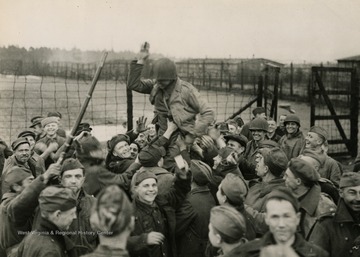
- IDNO:
- 041191
- Title:
- Russian Prisoners of War Liberated By Advancing U.S. Troops
- Date:
- ca. 1945
- Description:
- Information on back of photo reads: "Liberated Russians cluster around a Ninth U.S. Army soldier, carried high on their shoulders, for cigarettes, which they had not seen in many months. When the American finally convinced the Russians that he had no more, they "chaired" him and carried him around the yard before their former prison, the Nazi Stalag 326, south of Bielefeld. The first U.S. troops reached Stalag 326 April 2, 1945. Nine thousand Russian prisoners of war were liberated but thousands were at the point of starvation. Tubercular patients numbered 1,350. in vast mounds all around the camp, 30,000 Russians, most of them starved to death, were buried in heaps of 500. Major Gregory Matviev, who was captured in Sebastopol in 1942, reported that hundreds died daily of starvation and "about 50 were shot every other day for no reason at all.""
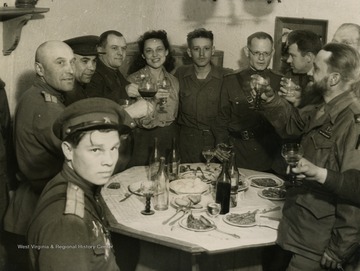
- IDNO:
- 041192
- Title:
- U.S. Troops Meet Russians in Torgau, Germany
- Date:
- ca. 1945
- Description:
- Information on back of photo reads: "Russians and Americans toasting each other after the link up at Torgau. Ann Stringer, U.P. Correspondent can be seen in the picture. Also man with beard on right, who is Correspondent Jack Thompson, of Chicago Tribune."
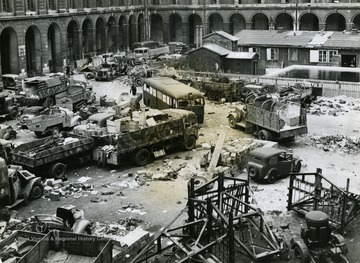
- IDNO:
- 041193
- Title:
- Abandoned Nazi Vehicles Fill Paris Courtyards, Paris, France
- Date:
- ca. 1944
- Description:
- Information back of photo reads: "Looking down on some of the wrecked and abandoned Nazi equipment left in the courtyard of the City Hall in the 10th District of Paris after the French capital's liberation August 25, 1944. The Nazis used the building as a telephone center and fortress. Their resistance was strong here and many members of the Maquis were massacred and buried in the courtyard."
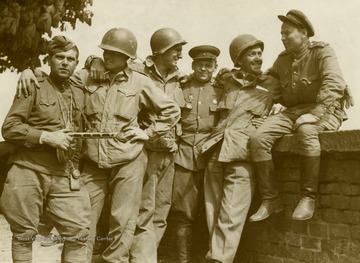
- IDNO:
- 041194
- Title:
- U.S. and Red Armies Link Up, Torgau, Germany
- Date:
- ca. 1945
- Description:
- Information on back of photo reads: "Firm contact has been established between ground forces of the First American Army and those of the Russian Army. The historic meeting took place in the town of Torgau, on the Elbe River, 75 miles south of Berlin, when First Army troops met forward elements of the Russian Guards Division."

- IDNO:
- 041195
- Title:
- Liberation of Russians in Stalag 326, Germany
- Date:
- 1945/09/04
- Description:
- Information on back of photo reads: "In Stalag 326 - 6K were nine thousand prisoners - all Russians. The U.S. 9th Army liberated them when they broke through to Eseslheide, s.east of Munster and n.east of Hamm. When the Russians realized that they were free they went wild. The Russians told us that 30,000 of their comrades died at the camp through privations, and 70 died of starvation each day." Picture shows: "American soldiers "chained" at Stalag 326 - 6K by Russians who were overjoyed when they found that they were free."

- IDNO:
- 041196
- Title:
- German Civilians March Through Newly Captured Zulpich, Germany
- Date:
- ca. 1945
- Description:
- Information on back of photo reads: "German civilians march through newly captured Zulpich, Germany, to receive instructions on their conduct from military government unit with 9th Infantry Division of 1st U.S. Army. Town was hard hit by U.S. bombers blasting path to Rhine."